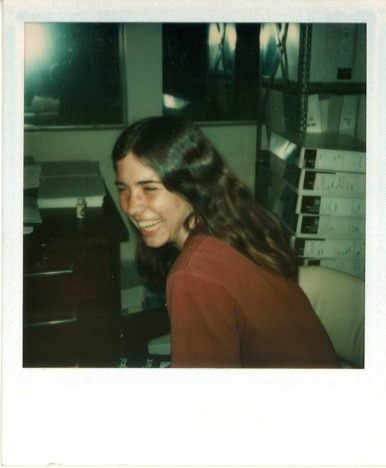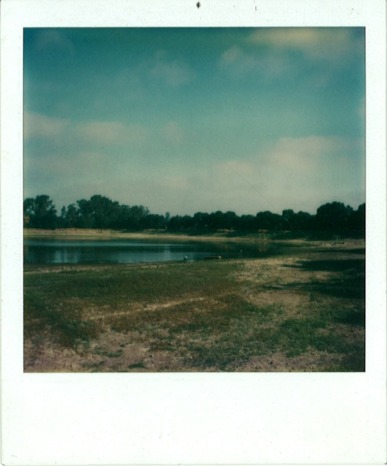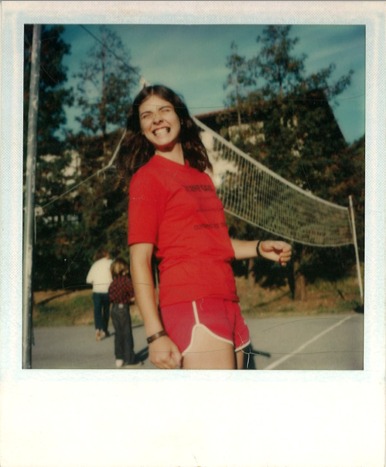
| Connect & Subscribe |
Recollections Of The Stanford Summer Sleep Camp
~A Conversation With Dr. Kim Harvey~
Written by Michael Rosenbloom, Winter 2012
Dr. Mary Carskadon stands at the front of Annenberg Auditorium and mentions a name - “Kim Harvey.”
Dr. Carskadon calls her one of the most important Stanford undergraduates helping her out at the Stanford Sleep Camp. Dr. Carskadon and Dr. Dement ran this camp to study how kids sleep, and Kim Harvey was mentioned again and again as such a great help with their work.
Meanwhile I’m sitting in shock - I know that name, and the person, really really well. She’s one of my mother’s best friends - they met way back in fourth grade and went to Stanford together. I’ve been to Christmas parties at her home in Palo Alto, I know both her daughters, and my mother told me that she was pregnant with me at her wedding!
 Dr. Kim Harvey at the Stanford Summer Sleep Camp, circa late 70s/early 80s
Dr. Kim Harvey at the Stanford Summer Sleep Camp, circa late 70s/early 80s
And now she’s being mentioned here, in a context I never expected - as a scientist and researcher, not as the down-to-earth pediatrician she is today. Most interestingly, I wasn’t the only one to recognize Kim Harvey’s name; several others also spoke up, saying they recognized her - as their pediatrician!
I knew then that I had to talk to her about what she’d done here, a part of her that Dr. Dement and Dr. Carskadon were telling me about, but that I’d never heard of from her. I asked her if I could interview her, so I could learn more about this side of her, a side that even my mother didn’t know that well. To my happiness, she accepted.
The Stanford Summer Sleep Camp was a critical early step in sleep research. From 1976-1985, Dr. William Dement and Dr. Mary Carskadon conducted sleep experiments at Lambda Nu, now known as Jerry House, at Stanford University. These experiments were some of the first to study adolescent sleep patterns, and the changes that happen to children’s sleep as they grow older.
We decided to hold the interview at my grandmother’s house. She lives within biking distance of campus, and it was quieter there than most of the interviewable places on campus. So, in between my grandmother trying to keep offering us food, I got to talk to her about these times, that for her were thirty-year-old memories, but had just been brought up by the woman she once worked with.
As it turns out, she got into the Sleep Camp by the same way many people at Stanford learned about sleep research: Sleep and Dreams! Yes, she took the class, many years ago, with Dr. Dement.
She recalls, “It was a big class, it was in Dinkelspiel. It was a very popular class... I probably still have my book, it was called, if I remember, Some Must Watch While Some Must Sleep, and Dr. Dement had written it, it was a small paperback book.”
From there, she enrolled in a study called the 90-Minute day, where the participants were effectively set on an eponymous ninety-minute schedule: sixty minutes awake, thirty asleep. It wasn’t a very successful experiment, but she met Dr. Carskadon and Dr. Dement there, and was drawn into helping at the Stanford Summer Sleep Camp. “Mary was going to be running a study on kids, a longitudinal study of sleep issues, sleepiness, change in sleep patterns, and also throwing in things like the development of narcolepsy on children between about age 10 and 15.”
She remembers the place where they held the camp, a place where, just a few weeks ago, a plaque was unveiled commemorating all the work done there and all the knowledge gained during the Sleep Camp. “It was one wing of Lambda Nu [now Jerry House, overlooking then-filled Lake Lagunita] which had four bedrooms, and was set up as a sleep lab. We blacked out the windows, so it was black in the room, and we had polygraphs, which we used to monitor their brainwaves and their muscle activity to score their sleep.”
 A water-filled Lake Lagunita back in the day. The Lambda Nu house is on the southeast side of the lake.
A water-filled Lake Lagunita back in the day. The Lambda Nu house is on the southeast side of the lake.
She was one of the supervisory technicians, keeping both the children and the other technicians under control, as well as doing research. She recalls vividly how they conducted some of the earliest real sleep experiments on children, done over the period of a few days each.
“Much of their time was structured. They went to bed in their rooms, there was this box on the headboard where we plugged in their wires that would go to the polygraph in the hall. So we plugged them in, and then they went to sleep, and we’d monitor them through the night; if they got up you noted it on the polygraph, if they went to the bathroom you’d note it...You got pages and pages and pages of paper from the machines, and if they ran out of ink you had to fix it, and if it ran out of paper you had to fix it, cause otherwise you lost data!”
There was apparently a giant computer in the anatomy building somewhere, but she never used it, so they all had to look through the data by hand, painstaking brainwave by brainwave.
“They [the kids] came back each year, and we monitored their stages of adolescence, to be able to correlate if it was an age, or a stage of adolescence, or what was it that changed the abilities during the day, and their need for sleep.”
So a child would begin at the Sleep Camp at ten years old, and would spend a few days every summer for five years getting studied to learn about sleep.
However, it was a Sleep Camp, not just a Sleep Study; for all the people involved, it was more a camp with science, than a study. She remembers that they “played volleyball after lunch, that was a highlight [Both her daughters are fantastic volleyball players]. We also took them bowling, there was a bowling alley in Tresidder, around where the bike shop is now. So we tied their electrodes into a little ponytail, and headed off to the bowling alley, with these four kids and four adults.”
 Volleyball was a highlight of the days spent at the Sleep Camp
Volleyball was a highlight of the days spent at the Sleep Camp
Both Dr. Carskadon and Dr. Dement had their own nicknames for these groups, I’m sure ones that just appeared: the undergrad helpers were the ‘techs,’ and the children with the electrodes stuck to their heads were the ‘trodes.’ It took too much effort to remove the electrodes just to put them back on every few hours, so they just left them on the whole time.
Funnily, although the current state of sleep research and education is focused on reducing people’s daytime sleepiness, she was tired most of the time during the Sleep Camp: “I had mono during one of the summers, so I was always tired then, and I didn’t realize it was because of the mono. One time I came home and my mom saw swollen nodes in my neck, and was sure I had lymphoma, and the doctor just said I had mono. He asked ‘aren’t you tired?’ and I said ‘I’m always tired, I work in a sleep lab!’”
She remembers the people that were there with her, from Dr. Dement and Dr. Carskadon, to others like Paula Duke, Tommy Anders, Poor George, and Joey Oliviera.
The experiences she had at the Sleep Camp still affect her current work, in both silly and serious ways. “Back when they were starting to do sleep research they had tried to study ‘do you need REM Sleep, do you need non-REM sleep?’ When they tried to do a study on just ‘do you need sleep?’ they of course had to have controls, and so the controls had to be lying in bed, relaxed, comfortable, warm and cozy, everything perfect, and then the other ones would sleep. So I tell my patients, ‘You know, they never could do that study,’ so what I tell them is ‘Maybe you don’t even need sleep, maybe all you need is the other stuff!’” So when you’re lying in bed, relaxed, comfortable, cozy, don’t be stressing about the fact that you’re not sleeping, cause maybe you’re getting what you need right now! [Laughing] And of course when you start to think like that, then you relax, and maybe that actually helps you to fall asleep. That’s my own personal little add-on. We’ve never proved it, because you couldn’t do the control!”
She goes on to describe how sleep phasing works in the teenagers she also sees: teenagers have different sleep schedules than adults and children, they stay up later and have trouble being awake in the early morning. This isn’t because of laziness, it’s just how teenagers work. “It’s kind of counter-intuitive, the sleep phase problem, and yet it clearly helps to start school later. So I tell kids in my practice that they can’t pick their school, but they can try very hard to get a first period prep, so at least they can sleep in.” So the Stanford Summer Sleep Camp comes full circle back to Sleep and Dreams.
Lastly, she offers a general comment to any interested in science: “Science is great! It’s fun to ask a question and REALLY get an answer. The day to day stuff can be fun too!”
And join the conversation with your own comments here:
blog comments powered by DisqusAbout This Site
Welcome! This site is continuously being created by students of Dr. William C. Dement's Sleep And Dreams course at Stanford University.
We made this site as a call to action for people all over the world to live healthier, happier, safer, and more productive lives by learning about their own sleep. We have faith that reading the information provided on this site will motivate you to be smart about your sleep deprivation and strategic about your alertness in order to live life to your fullest, most energetic potential.
In fact, we challenge you to do so! What do you say, are you up for the challenge?
Interviews With Sleep Specialists: Insights Into the Worlds of Sleep Medicine & Sleep Business
America's Most Dangerous Disorder: What Is Sleep Apnea Doing To Your Sleep?
Sleep Debt: How Much More Will You Achieve When You Reduce Yours?
The Stages Of Sleep: The Journey Through The Night
Delayed Sleep Phase: You Want To Sleep But You're Not Tired Yet
Paralyzed at Night: Is Sleep Paralysis Normal?
Sleep In Words: Smart, Strange, and Funny Quotes About Sleep
Sleep Disorders In Children: What's Keeping Your Child From A Full Night's Rest?
Attacks of Pavor Nocturnus (a.k.a. Sleep Terrors, Night Terrors, or Incubus Attacks)
The Stanford Sleep Book
Dr. Dement's pioneering textbook has been the core text for Sleep and Dreams since 1980, but it has just recently been made available to the wider public for the first time.
In it you'll find a more detailed account of the most important things you need to know about sleep, alertness, dreams, and sleep disorders. Studies, statistics, plus plenty of Dr. Dement's classic anecdotes painting the history of sleep medicine.
Preface | Intro | Contents | Get A Copy
More Sleep Resources
The Zeo
A revolution in personal sleep tracking, the Zeo is a wireless headband that transmits your brainwaves in realtime to a dock (pictured here) or your smartphone. The result? You can wake up and see exactly what stages of sleep you were in during the night! Unprecedented personalized sleep knowledge.
Sleep Paralysis: A Dreamer's Guide
Ever woken up paralyzed? A surprising number of us have, believe it or not. But few know the actual causes of this phenomenon, and fewer still how to exert control over it. Dream researcher and sleep paralysis expert Ryan Hurd shares breakthrough insights into how to do just that.
Important Disclaimer
Please Note:
The information found on this page and throughout this site is intended for general information purposes only. While it may prove useful and empowering, it is NOT intended as a substitute for the expertise and judgments of healthcare practitioners.
For more info, see our
Terms of Use.









